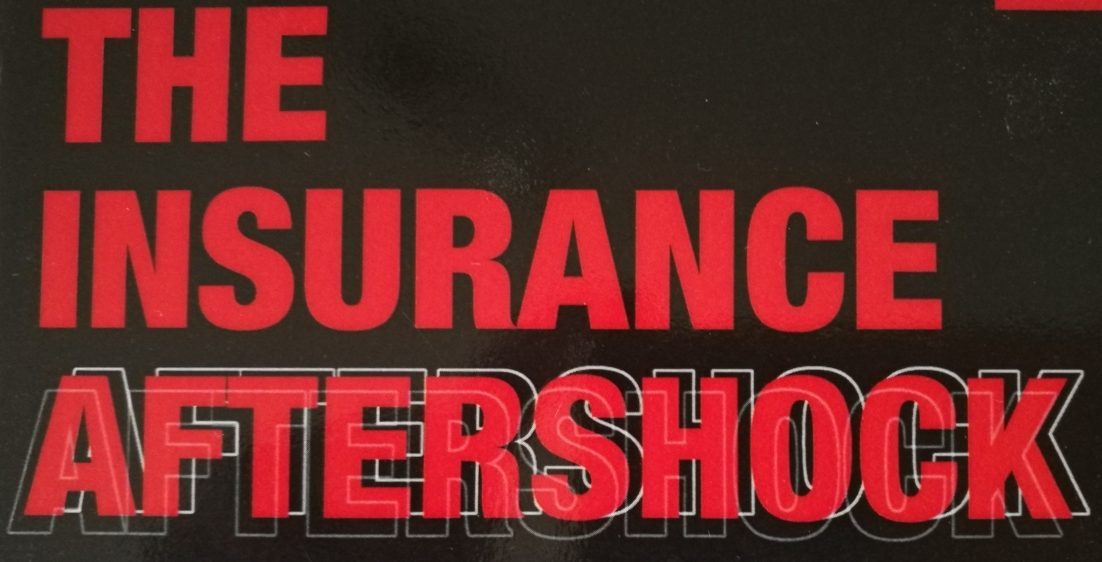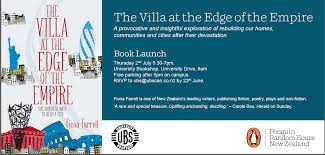Last week I attended the book launch of the book Villa at the Edge of the Empire by Fiona Farrell. She was the recipient of the Michael King Writer’s Fellowship in 2013 and was to write twin books, one fiction and one non-fiction. Both books are titled ‘The Villa at the Edge of the Empire’. See http://www.stuff.co.nz/the-press/news/christchurch-earthquake-2011/8777317/Fiona-Farrell-to-pen-quake-books.
Her book launch was for the non-fiction book. Fiona and her book were introduced by fellow writer and friend, James Norcliffe and the passage below is an excerpt of his wonderful introduction to Fiona’s book.
“The earthquakes which destroyed our lovely city marked all of us who live here, and scarred so many.
Joan and I actually missed the September earthquake – we were in Blenheim visiting Joan’s mother, and when we missed the New Year earthquake, being once again in Blenheim we were in a perverse way disappointed, as if we’d missed out on an experience. We were earthquake virgins we quipped.
It was easy to quip, for those initial earthquakes were sort of like neutron bombs in reverse – you know the neutron bomb, which destroys people but leaves buildings and infrastructure intact. Those earthquakes had damaged buildings and infrastructure but had left people largely unscathed. No deaths!
How smug we were, how better equipped and prepared we were than those who lived less enlightened places, places without decent building standards and regulations, places like Agadir, Izmit, Szechuan…
And then of course came February 2011. We didn’t miss this one. We were in a three-story brick building at Lincoln University. Later we drove home through upheaval, liquefaction and aftershocks, both physical and emotional.
No more quipping. No more smugness.
O’Henry gave his collection of short stories about New York the title The Four Million, his point being that everybody living there had a story. Everybody who has lived in Christchurch these last five years has a story too, and I might add a poem. Fiona recognising this gave some of these people voices in The Quake Year her Studs Terkel like collection of individual experiences, people like us usually dealt a raw hand, but getting on with it, mucking through.
The Villa at the End of the Universe is a different sort of book. This is a book that digs under those stories to ascertain how and why things happened here and what could and should have been done in a different way. This book ranges far and wide. For instance, a series of chapters deals with L’Aquila, the ancient Italian town devastated, not for the first time, by an earthquake, the latest not too long before that which hit Christchurch. Fiona visits L’Aquila and is thus able to compare and contrast the very different approaches taken by these very different cities. The differences are salutary.
You could say the book ranges high as well. Fiona’s opening set of chapters is called the map. She says “when we behold a map we become, for a second, God, surveying an orderly creation.’ It is an objective view from on high above the microscopic billions and all the mess and flurry of life. The skittering, she calls it. She precedes these thoughts with a brilliant reframing of the so called flyover of hope, the vision that will inspire the world – we all saw it on our computer screens was it only four years ago? Remember the cheerleader voiceover, the inspirational music, the city erased and then reconfigured. A blueprint we were told, and Fiona adds: a blueprint for concrete, tarmac and cement. A map for an everyday future.
We are reminded that despite the shocks, the sheer awfulness of what had happened, there was a moment when people came together, not just to help each other as they did, but to dare to imagine a future. Ideas and dreams were collected, collated and promulgated. While there was tragedy, there was also opportunity, the opportunity for a new beginning, a reshaping, a moment when a new type of Christchurch was briefly possible. After taking us back to Christchurch’s origins as a planned city, to Wakefield & Godley & sufficient price, and thence to her personal journey, we arrive at the earthquakes, CERA, Gerry Brownlee and old dungers.
The 160,00 collected ideas and dreams of 60,000 submitters were distilled into The Draft Central City Plan for Ministerial Approval. Fiona then comments that when presented with the plan that minister did not approve, not entirely & the plan was transformed into the 100 day Blueprint with its great yellow lego-like blocks called Anchor Projects only a few of which the people had dreamed of. Emphasis was given to the huge sports stadium with or without a retractable roof, the sporting precinct, and the massive convention centre.
The liveable city dreamed of – which had seemed to channel Lewis Mumford’s ideas of bioviability and biotechnics with its parks, trees, neighbourhoods and human scale had been elided somehow. There was no light rail and retail was to be offered only to merchants who needed a floor space of 7000 sq metres, deemed the minimum size to avoid what the minister called “hotchpotch” something he apparently abhors. Big boxes in, small specialty stores out.
Somehow the word hotchpotch chimes and I’m reminded of Baxter’s Wild Bees. You may remember the poem. He wrote about the beehive (not the one up north), the city of instinctive wisdom, he and his friends destroyed, a job he said well-botched.
It’s too early to say whether the opportunity to rebuild a human Christchurch the Christchurch the world was supposed to be inspired by (according to the flyover) the glittering dream, has been well-botched, but as I said, I am gloomy.
Even in the days since the The Villa at the End of the Empire was published we have seen things that have added to the gloom, the despondency. The demise of John Campbell – the one honourable exception according to Fiona – among the national media’s amnesia about Christchurch; the NIMBY protest about a recycled house appearing in a new subdivision in Burwood; the putting on hold of the Breathe urban village which was to be built and still may be on Madras Street – and, by the way, why just one Breathe village? Why could twenty of the best designs not have been built? Forget the damned motorcar, said Lewis Mumford again, build cities for lovers and friends.
Of course, pre earthquake Christchurch did have a number of urban villages, perhaps the most famous being the Avon Loop, and Fiona who once lived there devotes the second section of the book to what it was and what it came to be. More old dungers, of course. Red zoned as so much else.
The third section deals with L’Aquila, the Italian city struck by an earthquake, a year before Christchurch’s first big quake. Fiona teases out the similarities and the differences in the responses to their respective disasters. The emphasis on one being restoration and the other being erasure and reconstruction, one planning for the future with reference to the past, the other not so much. Fiona says: “restoration makes sense to people in a country where hundreds of thousands of children are educated to see themselves as part of a tradition, rather than as individuals or entrepreneurs.” It’s the old country new country divide.
This a most important section and should be widely read. Fiona is fair and judicious and although comparisons are said to be odious, these comparisons give much to think about.
The final section is the title section. The Villa at the edge of the Empire, and the villa of the title we learn is a Roman villa that was uncovered in rural Britain, and the empire is the Roman Empire. These are perhaps the most meditative pages of the book and Fiona’s wide ranging reading, fierce intellect and ability to pull together so many strands make for compelling reading. The pages also raise demanding questions underscoring the book’s importance. A visit to red-zoned River Road where she walks among the ruins or the now empty sections where the ghost houses of friends once stood, prompts memories of archaeology, thoughts of empires old and new, of the New Zealand dream as articulated by Seddon, by the 1906 Christchurch International Exhibition in Hagley Park, and by the welfare state. We are forced to confront the realities of the new world we have replaced this dream with, the world of private insurance, the world of shock economics, the world of Gerry Brownlee. New Zealand over the last thirty years has been a petri dish, Fiona reminds us, in which new ideas have been fomented; the earthquakes have in many ways been a litmus test of those ideas.
This is not a book about liquefaction and seismic shudders – in fact the word liquefaction is barely mentioned and only makes an appearance after a 100 pages or so. It is about us; what has happened to us; what we have become and what we could still be. It is a book to read and re read. In other words, this is an important book and a wise one. You will probably read it as I did – all 100 not so tiny pieces – in one rapt sitting.
It is a magnificent achievement Fiona. I feel privileged and proud to have been asked to launch it.” From http://jamesnorcliffe.com
I am currently reading the Villa at the Edge of the Empire and thoroughly enjoying her contribution to an event which will no doubt go down in New Zealand history as a major ‘hotchpotch’. A Penguin, Random House publication available at all good book shops.

